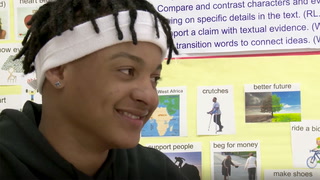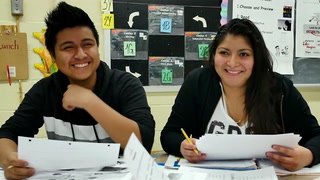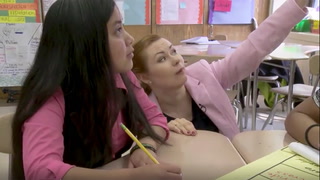Nafia Tie: Hi, my name is Nafia Tie, I am the SIFE ENL teacher here at Brownton High School.
Renada Hewitt: My name is Renada Hewitt, I am an ENL teacher and I teach integrated ENL, ELA class to SIFE.
Nafia Tie: In the stand alone class, there are four centers. The rationale behind having centers for students is that they have differentiated instruction at each center. In the first center, the students come to GRW center, which is the Guided Reading Center, where the students have some support from the teacher. The next center that go to is the Writing Center, where they can write about topics, about pictures.
In the Foundational Center the students learn power words. In the Independent Reading Center, the students are reading text at their own reading level that is interesting to them.
Renada Hewitt: The level of central texts in integrated ENL ELA class are higher than students proficiency level. So in order for them to understand what they're reading, we have a lot of scaffolding.
Nafia Tie: Students are very comfortable writing their answers. They are very uncomfortable speaking. So, we have decided ... We made a focus this year, to have them always retell before they write.
[crosstalk 00:02:55]
Nafia Tie: Today we are going to learn more about a book that my students have been reading at their own level. With the thinking map that they have, they're going to produce writing.
"Okay, I'm going to read it and say it in my native language, "what's my native language?" [crosstalk 00:03:13] Very good, okay ready?
The river runs into the ocean. Now the water is in the ocean. [inaudible 00:03:27]
It is important to use home language when you're learning a new language because you can think abstractly in your home language that you might not be able to transfer it over to a new language. Because they can problem solve in home language. [crosstalk 00:03:49]
Speaker 3: [crosstalk 00:03:45] We do [inaudible 00:03:59] water [crosstalk 00:04:03][inaudible 00:04:03]
Renada Hewitt: What are we learning about here? Water. Can you write that in the middle? Water. And I'm going to write text. Can you continue doing that? Create the categories for me on your map.
Speaker 3: [inaudible 00:04:14] Four categories: news, types, needs, [crosstalk 00:04:20]
Renada Hewitt: Problems.
Nafia Tie: We use cluster maps because it is a visual that students can easily see. They're taught to organize on paper which gives them the main idea and details.
Renada Hewitt: Okay, Identify details.
I use a map to identify details. Great. Great work. I also use this to organize my thoughts, okay, because I know a lot about water but let me see if I can organize the information that's in my brain onto paper. Right? And then this could help me maybe, to write. And that's what we are going to do now. We are going to use this map to write about it, okay?
Give me an example.
Speaker 4: I need my ... I need water.
Renada Hewitt: Okay.
Speaker 5: The people need water to live.
Renada Hewitt: Okay.
Speaker 4: [inaudible 00:05:16] Drink water.
Speaker 7: To drink.
Renada Hewitt: To drink. Okay, great! So for example [crosstalk 00:05:21]
Students get practice saying it before they transfer to writing.
Alright so I'm going to give you the words and you're going to the next answer okay guys?
In the stand-alone class we use a lot of resources that help students with writing. The concept maps, the graphic organizers, the thinking maps, the language tense, the vocabulary, the categorizing.
Speaker 7: [crosstalk 00:05:55]
Speaker 4: [inaudible 00:06:00] [crosstalk 00:06:05]
Nafia Tie: What surprised me the most was: my students were in charge. They were negotiating details on their own. My students are really taking charge and they're becoming independent learners.
Renada Hewitt: This lesson will focus on transferrable skills. Today we will be focusing on annotating text and trying to find facts in a text that we can retell of how people use ... get water and what problems with the water are in the places where they live.
Speaker 7: [inaudible 00:06:53]
Renada Hewitt: So why is clean water essential for all people?
However this week we said our focus was: how do people get and use water. What does that mean? So please take your text out.
So it's overwhelming for these students to be able to find information in texts and understand what is important and what's not. We are focused on essential questions for the unit or even just the weekly set.
Agua carriente. Okay.
So there is no running water, no agua carriente, in the village. So Berthena and her sisters must collect their water from a spring. There is no running water.
What is that? How to get, use, or a problem?
Speaker 7: Problem.
Nafia Tie: Problem. That's right. There is no running water. Okay. So this is a problem.
Renada Hewitt: We use a lot of language tense, we prompts, sentence starters, thinking maps. We use glossaries and translate in the native language, sometimes with pictures, sometimes just translations.
Speaker 8: [crosstalk 00:08:25] want to buy a taco.
Nafia Tie: Using water and cooking and cleaning and laundry.
Renada Hewitt: Okay beautiful, so cooking cleaning and laundry is how she uses water. Uses water. Excellent. Cooking, cleaning-
I love using general specific map because it categorizes information. It's not just like a brainstorm and concept map when you have a circle and then everything is spread out and you can't make sense of all this information. You just have it scattered around.
Where do you write that? Does it go here or here? Ah, how does she get water? In buckets, right?
With what you wrote, practice to say it to your partner. Berthena gets water from the spring. Very nice. She uses water to ...
Speaker 5: [inaudible 00:09:29] water [inaudible 00:09:29]
Speaker 4: Not running water
Renada Hewitt: Students say sentences before writing in order to help them process their thinking. When they speak with their partner it is their own peer who has similar language proficiency so they don't feel intimidated by speaking; taking that risk.
We always provide either sentence prompts or sentence starters so they can fall back on that as a scaffolding.
And now let's just write the same sentences. Whatever you just said to your partner, write it down. For example, I wrote a sentence. Berthena gets water from the spring. That's what I will write.
Wash
Eric? You want to share one?
Speaker 3: Berthena get water from a tap in the bucket and the spring.
Renada Hewitt: Ooh. Excellent.
Speaker 5: [inaudible 00:10:40]
Renada Hewitt: Gets water
Speaker 5: [inaudible 00:10:49] a tap
Renada Hewitt: From a tap.
Speaker 5: [inaudible 00:10:53]
Renada Hewitt: and ... So I have how she gets water. I know how she uses water and I have a problem, a water problem.
I really like the way you worked with your partners. I like how you used Spanish to explain to each other. I really liked you using annotation of all the words that we had in glossary.
So through this course, I have learned how to teach students to read text that's more difficult, how to understand what you're reading by finding context clues. It has taught me how to teach the vocabulary so they can remember it and transfer it.
It has taught me how to teach them cognitive thinking about academic learning because the bottom line is teaching this integrated ENL ELA course is teaching transferrable skills to students so they can apply to every content area.
Nafia Tie: And giving students opportunities to discuss information in pairs is just a crucial step of learning a new language and learning content information that might be new to them.
I'm a second language learner and an immigrant who came to this country at eleven years old. The girl that was in the back of the classroom that did not speak much because she didn't have any tools or visuals. I'd would like to say that I'm making it happen for my students.
Renada Hewitt: As an immigrant myself as well as second language learner, I find it extremely helpful to be a teacher to SIFE.
Nafia Tie: So I know to give those opportunities to my students and to open the door to expand their knowledge. It's not a block in the way, it's actually a bridge to success.















4 Comments
Laura Waitulionis Jul 25, 2021 3:33pm
The courses are designed to increase metacognition for the students, so they can better understand the categories and relationships between words and texts. The three steps for students are to read and retell a story, create an organizational map (concept maps or thinking maps), and speak and write the language. The learning centers cater toward each student's particular strengths or areas where they can improve. It helps students scaffold knowledge and apply this new knowledge in all areas of their education.
Kelsey Pratt Nov 16, 2020 10:37am
1.) To begin with, the two bridges courses are designed to meet the needs of SIFE through providing them with the tools they need to bridge between their native and target languages. In the non-integrated ENL classroom, SIFE are able to participate in a number of centers to practice their reading, writing, and speaking skills either independently or with the guidance of the instructor. By working closely with the instructor to develop abilities such as identifying the main idea of a text and then composing an independent response, SIFE construct the knowledge they need to participate in the integrated ENL/ELA classroom. Through providing texts that are higher than their current proficiency level and scaffolding, the ENL instructor pushes the students to think critically and organize their thoughts in a way that prepares them to effectively write in the target language.
2.) The three- step protocol for SIFE includes "read and retell," "organize ideas in a thinking map," and "speak and write." As the integrated ENL/ELA teacher discussed, it is critical for SIFE to explain their thoughts before they write them down, as this allows for them to give shape to their ideas. The ENL/ELA instructor encouraged them to effectively organize their thoughts by requiring students to fill out a general-specific concept map that addressed the essential question: "How does the woman in the text gather and use water?" Once they filled out their concept maps with clear examples from the text, the students were able to turn and talk with eachother in groups and discuss the different ways that the woman used water as a resource in relation to cooking and cleaning. Through breaking the main topic down, the students identified subtopics that they could use to construct a short response essay.
3.) Overall, the four centers incorporated into the ENL classroom allowed for effective differentiation. The SIFE had the opportunity to move between a guided reading station, foundational 'power word' station, an independent reading station, and an indepdendent writing station. In the guided reading center, students who could not yet identify key concepts of the text on their own could do so with the help of the instructor. As the students discussed the different ways in which water was gathered and used within the book, the teacher used an interactive white board to construct a web-shaped concept map and jot their ideas down. She also used a sentence starter to help the students establish the main idea of the text, which they may have not been able to do as effectively on their own. All of the approaches that the insturctor undertook were intended to help the students develop clear thoughts that they could incorporate into their independent writing responses.
Cade Patterson Jun 21, 2019 12:36am
This video really interests me because in my future I want the opportunity to teach special education. With working with students who need more help it is important that you have lesson plans and opportunities for them to improve their education no matter the age or grade level you are working with. I am extremely excited for my future of becoming a new teacher and hopefully get the opportunity to work with special education students.
Phyllis Grana Sep 12, 2018 1:48am
You have inspired me to use centers in my 6th, 7th, and 8th-grade combo classes. This is my first year teaching Middle School ELL. I have previously taught only in the elementary school. What a transition.